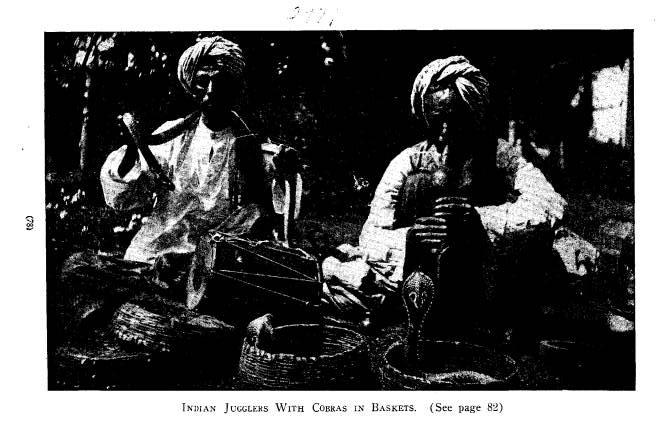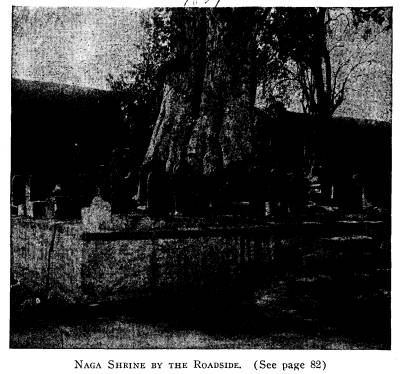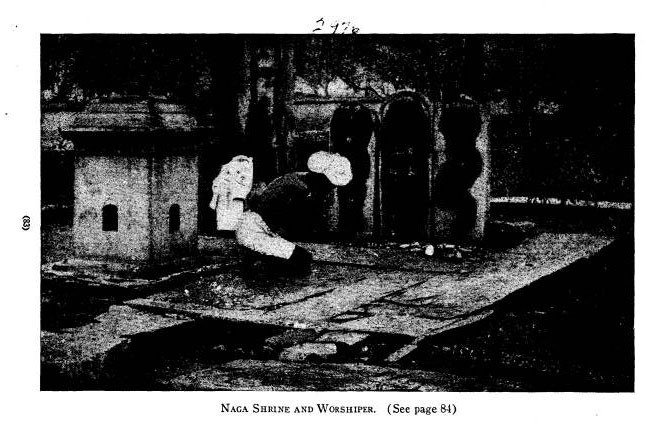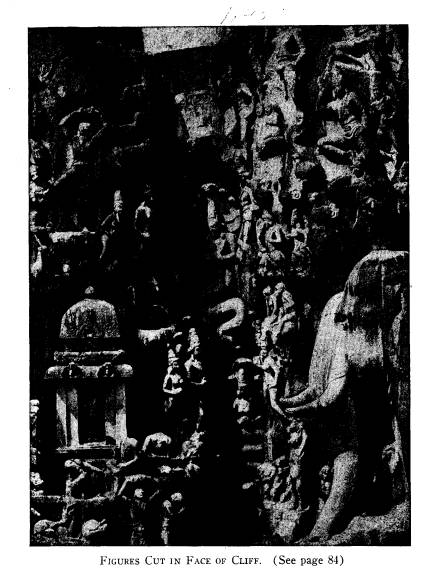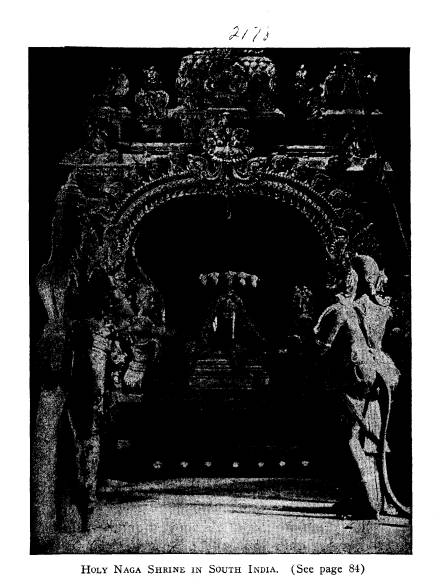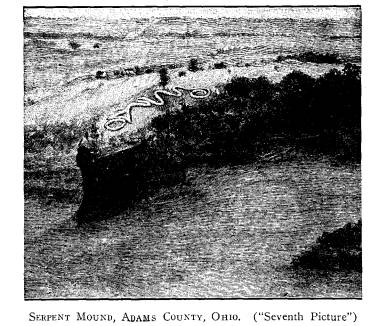Ohio History Journal
- 1
- 2
- 3
- 4
- 5
- 6
- 7
- 8
- 9
- 10
- 11
- 12
- 13
THE NAGA AND THE
LINGAM OF INDIA AND THE
SERPENT MOUNDS OF
OHIO.
BY ALEXANDER S. WILSON, M. D.,
Kodaikanal, Madura District, India.
WITH INTRODUCTION BY G. FREDERICK
WRIGHT.
INTRODUCTION.
About the middle of the last century
Mr. Lewis
Morgan, a distinguished citizen of
Rochester, New
York, became interested in the manner
of reckoning
family relationships among the Iroquois
Indians of cen-
tral New York. The system was very
complicated and
complete. As many as 237 relationships
were expressed.
The system was totally different from
that prevalent
among the Anglo Saxons and affiliated
races. The
Anglo Saxons limit themselves to
tracing direct relation-
ships, son, grandson, great grandson,
father, grand-
father, great grandfather, etc. But the
Iroquois system
was that of clan relationships. As
illustrating the com-
plication of the Iroquois system we
note that in it
"mother's mother's mother's
sister's daughter's daugh-
ter (older than myself)" is
regarded as my elder
sister. "My mother's mother's
mother's sister's daugh-
ter's daughter's daughter's daughter is
regarded as my
daughter." Examination showed that
this system was
essentially the same as that of other
tribes of North
American Indians.
In 1859 Mr. Morgan happend to meet Dr.
Henry
W. Scudder, for a long time missionary
of the Presby-
(77)
The Naga and Lingam of India. 79
terian church among the Tamils of
southern India. On
seeing this classificatory system of
relationships among
the Iroquois, Dr. Scudder said that it
was almost identi-
cal with that in use among the Tamils
of India, and that
the correspondences were so many and so
peculiar that
there must be a connection somewhere in
the past be-
tween these now widely separated
tribes. In short they
had descended in prehistoric times from
a common
center. Whereupon Mr. Morgan began a
series of in-
vestigations under the patronage of the
Smithsonian
Institution of Washington and collected
from tribes and
societies all over the world the facts
concerning the reck-
oning of relationships among both the
Aryans who fol-
lowed the direct lines and the Turanian
races who were
organized into clans. The great work
was published as
"Smithsonian Contributions to
Knowledge," 218, in
1871; and was entitled "Systems of
Consanguinity and
Affinity of the Human Family,"
forming a volume of
nearly 600 quarto pages, full of tables
giving the differ-
ent systems enumerated, with
appropriate descriptive
matter. The result of the work in Mr.
Morgan's opinion
fully confirmed the inference of Dr. Scudder,
that the
American Indians and the Tamils of
southern India
had, in prehistoric times, occupied
common ground and
from that center had carried with them
their peculiar
classificatory system of expressing
consanguinity. So
that, after all, Columbus was not so
much mistaken in
calling the inhabitatnts of America
Indians.
It is interesting to note that now,
after the lapse of
half a century, one of the successors
of Dr. Scudder in
the missionary work among the Tamils
comes to a repre-
sentative of the Ohio Archaeological
and Historical So-
|
80 Ohio Arch. and Hist. Society Publications. ciety to say that two of their most highly valued archae- ological relics, the serpent mounds of Adams and War- ren counties, give incontestable evidence from another source that there must have been a prehistoric connec- tion between the mound builders of Ohio and the Tamils of southern India. The Ohio serpent mounds represent a class of serpents that did not exist in America but are |
|
|
|
superabundant in India and worshipped by the inhabi- tants in great detail. Dr. Wilson's article must speak for itself. THE NAGA AND LINGAM OF INDIA AND THE SERPENT MOUNDS OF OHIO. (BY DR. WILSON.) India is often spoken of as the most religious coun- try in the world, and enjoys the unique distinction of |
|
The Naga and Lingam of India. 81 having actually more gods than people within her bor- ders, though her population, by the last census, is well over three hundred million. The reason for this lies in the fact that, with the decline of Buddhism about the sixth century A. D., Brahmanism reasserted its supremacy, and in the grand rennaisance which fol- |
|
|
|
lowed, succeeded in blending all of the previous religious systems of India into one, without throwing out any of the deities, or giving serious offense to their devotees. This compound-complex combination is modern Hindu- ism. But, among all its millions of gods, probably none is more ancient than the Naga, the hooded cobra (Cobra Vol. XXX- 6. |
82
Ohio Arch. and Hist. Society Publications.
di Capello), a venomous snake averaging
about four
feet in length, and found everywhere
over the whole
land. Its bite accounts for thousands
of deaths every
year, but so sacred is it, that no
Hindu would think of
killing it. On the contrary, offerings
of milk are poured
into the holes in the ground where it
is known to dwell,
and it is shown every courtesy and
consideration. Cobra
worship was undoubtedly practiced by
the aborigines,
long before the Arayan invasion. The
serpent has
figured prominently in the animistic
religions of all
races, and is found in the mythologies
of all lands.
Even the casual traveller is impressed
by the num-
ber of shrines to the cobra-god, and it
is safe to say that
scarcely a temple in India is without
this decoration, no
matter to what major deity it may have
been erected.
And what is equally striking is that
with an abundance
of material to serve as living models
for the artists,
the representations one sees are of a
very conventional
type, with oftentimes very little
attention to the char-
acteristic markings of the original.
Compare, for in-
stance, the cobras shown in the
following photographs
of Indian jugglers, with the sculptured
Nagas. In the
first picture are two cobras in
baskets, with their heads
raised and hoods spread. The one to the
right shows
plainly the characteristic
"spectacle" mark on the back
of the hood, conferred on him as a
special mark of
honor by the great god Brahm. In the
second picture,
two cobras are shown, one of them, in
part-profile. The
third picture shows an ordinary Naga
shrine by the road-
side. These are found by the thousand
in India, and the
twined cobras represented are of a very
conventional
type.
84
Ohio Arch. and Hist. Society Publications.
The fourth picture shows three types of
figures. On
the left, the twined Nagas, as in the
previous picture.
In the center, two Nagas inclose
between them the form
of a god or goddess, their hoods
blending in one, along
the margin of which are five heads. At
the right, there
is one serpent, with one hood, and
seven heads. The
point I wish to emphasize is the wide
departure from the
original, in a land swarming with cobras.
This is shown
also in the fifth photograph of figures
cut in the face of
a cliff. In the center above, is a Naga
whose enormous
hood, with seven heads, shelters a god,
while below, a
goddess is protected by a hood which
seems to have but
three heads.
Probably from the same aboriginal
source as Naga
worship, and of equal antiquity and
sanctity, is the wor-
ship of the lingam, the deification of
the reproductive
organs, usually of the male but
sometimes of the female
also. Max Mueller euphemistically
speaks of this as
the veneration of creative power in
nature. Here too
Hindu art uses a purely conventional
form. Millions
of followers of this cult keep their
god with them night
and day, in a small metal box, worn
suspended from the
neck by a string. In the box is a small
disc of stone,
with a slightly rounded elevation on
one of its flat sur-
faces. The figures in the shrines,
however, are usually
more elaborate. At one of the most holy
places in South
India, is a shrine, which is visited
annually by hundreds
of thousands of worshippers. And there
we find that
the lingam, represented by a short
column of stone, is
sheltered and protected by the
widespread hood of a
huge Naga, and the hood is bordered by
five heads.
This is well shown in the sixth
photograph.
|
|
|
(85) |
86
Ohio Arch. and Hist. Society Publications.
Much has been done to establish a
common origin
for the American Indians and the
Dravidians of South
India. There are said to be many
striking language
similarities; but that the strongest
resemblance is in the
constitution of the family group. I
believe that in the
monuments left by the Mound Builders in
Ohio we have
another very strong link in this chain
of evidence. It
is hard to conceive of the two great
serpent mounds
found respectively in Adams and Warren
Counties as
having been constructed from other than
religious mo-
tives. It is impossible to think of
them as works of de-
fense, or constructed for any
utilitarian purpose. The
mound in Adams County is particularly
striking. Of
it the Encyclopedia Brittanica says,
"It is a gigantic
serpent made in earth. Across the
widely-opened jaws it
measures seventy-five feet; the body
just behind the
head measures thirty feet across and is
five feet high;
and, following the curves, the length
is one thousand
three hundred and forty-eight feet. The
tail is a triple
coil. In front of the monster is an
elliptical inclosure
with a heap of stones at its
center."
Many fanciful explanations of this
strange monu-
ment have been offered. Prof. F. W.
Putnam says that
"The jaws of the serpent's mouth
are widely extended,
in the act of trying to swallow an egg,
represented by
an oval inclosure" etc. I offer
the suggestion that the
builders were here trying to represent the
Naga and
lingam. Separated by many centuries from their
Asiatic home, they still cherished some
tradition of the
emblems, and in representing them, have
not departed
further from nature than has the modern
Hindu, in the
conventional forms above noted. The
seventh picture
is a photograph of the illustration
appearing in Dr.
|
|
|
(87) |
|
88 Ohio Arch. and Hist. Society Publications. Wright's book on The Origin and Antiquity of Man in the chapter on the Mound Builders. It will be seen at a glance, I think, that here was an attempt to repre- sent a hooded serpent, and this is brought out much more plainly in the photograph which is the frontispiece of the Report of the Archaeological Society of Ohio. It |
|
|
|
must be remembered, too, that there is no hooded snake in the Americas. The last picture is a crude copy of another illustra- tion in Dr. Wright's book of the Serpent Mound found in Warren County. Here it seems to me that the attempt was to represent the hood in profile. Com- pare it with the profile of the cobra shown in the second picture noted above. In this case I am informed that |
|
The Naga and Lingam of India. 89 the nearby creek has eroded a part of the head of the monument, and may have obliterated the lingam, if one existed. This point ought to be carefully investi- gated by those who are in a position to consult the oldest descriptions and drawings of this mound. There is a large possibility of further light being thrown upon the problem of the origin of our American |
|
|
|
Indians along the line I have indicated in this paper. "In Mexico sculptured images of serpents are found as large, and as carefully wrought, as those of India." * These should be most carefully scrutinized for evidences of a hood or lingam. The hieroglyphics of Central America and Yucatan should also be carefully searched. * The Encyclopedia Americana. |
THE NAGA AND THE
LINGAM OF INDIA AND THE
SERPENT MOUNDS OF
OHIO.
BY ALEXANDER S. WILSON, M. D.,
Kodaikanal, Madura District, India.
WITH INTRODUCTION BY G. FREDERICK
WRIGHT.
INTRODUCTION.
About the middle of the last century
Mr. Lewis
Morgan, a distinguished citizen of
Rochester, New
York, became interested in the manner
of reckoning
family relationships among the Iroquois
Indians of cen-
tral New York. The system was very
complicated and
complete. As many as 237 relationships
were expressed.
The system was totally different from
that prevalent
among the Anglo Saxons and affiliated
races. The
Anglo Saxons limit themselves to
tracing direct relation-
ships, son, grandson, great grandson,
father, grand-
father, great grandfather, etc. But the
Iroquois system
was that of clan relationships. As
illustrating the com-
plication of the Iroquois system we
note that in it
"mother's mother's mother's
sister's daughter's daugh-
ter (older than myself)" is
regarded as my elder
sister. "My mother's mother's
mother's sister's daugh-
ter's daughter's daughter's daughter is
regarded as my
daughter." Examination showed that
this system was
essentially the same as that of other
tribes of North
American Indians.
In 1859 Mr. Morgan happend to meet Dr.
Henry
W. Scudder, for a long time missionary
of the Presby-
(77)
(614) 297-2300
